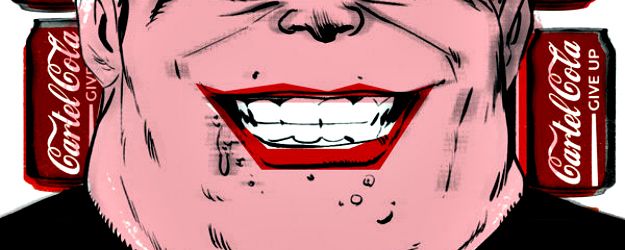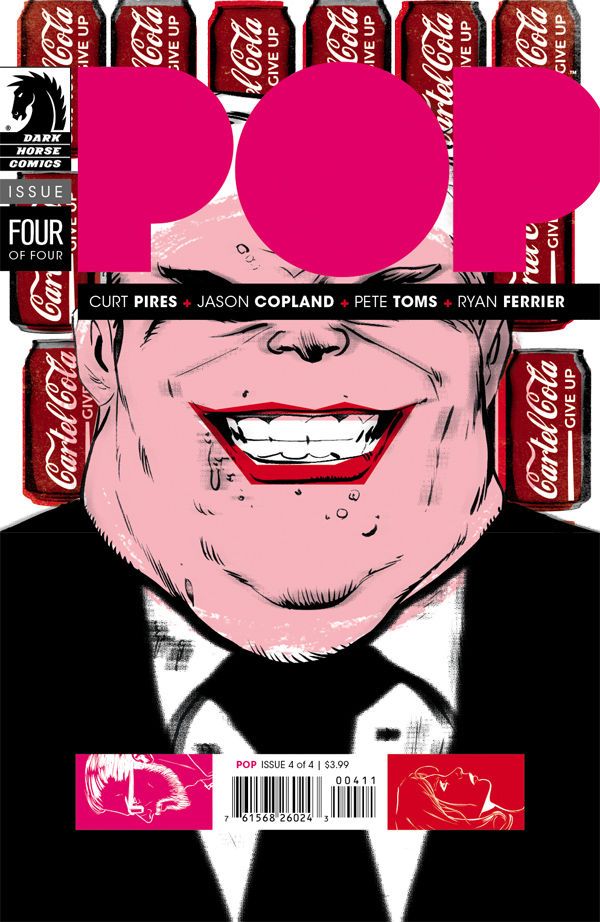POP, writer Curt Pires' collaboration with artist Jason Copland and colorist Pete Toms, wraps up this week with the release of Issue 4 from Dark Horse. One thing I consistently enjoy about Pires' storytelling is how it works on two levels: You have a plot replete with action that always keeps the reader engaged, along with with a layer of subtext that invites deeper consideration.
In an interview with ROBOT 6, Pires allowed me to poke around both layers. Suicidal ideation, drug use and poetic terrorism are just a few of the concepts considered in POP, and in this interview.
Tim O'Shea: In Issue 2, there's a major drug-related hallucination scene. I'm not joking when I ask this, but how much did you research before writing the scene, and what kind of direction did you give Jason on how to approach it?
Curt Pires: That scene in particular there was quite a bit of research. I’m open to, and have experimented with, many drugs, if only in the interest of expanding my consciousness, but alas not DMT [Dimethyltryptamine] at this point. Gaspar Noe’s extensive sequences in Enter the Void [the 2009 French avant-gard film] in which the main character uses DMT were sent to Jason as a point of reference. Another point of reference: the work/teachings of Terence McKenna (who is also referenced in the issue).
How early in the development of Issue 2’s script did you come up with the Jackson Pollack line? Was it before or after you had seen some of Jason’s ability to pull off quite visceral violence?
That actually came to life during the dialogue pass, which I write after I see the art. So that was really one of those magic “only in comics” moments of me seeing the art, pulling the words out of myself, and the two worlds intertwining.
Issue 3 features some experimentation with non-traditional coloring. Was that requested by you, suggested by Jason, or offered as an option by Pete?
Like all good things, I think it was really the result of collaboration. The initial concept to experiment with color on those pages came from my desire to create an almost pop-art feel to the pages, to experiment with the reality of the comic and its status as an art object. “We’re all beautiful holograms”; it’s encoded into the page. Pete came back with the colors you see in the printed version, which differed from what even I had in mind, and we went with those, because they felt alive, and different and beautiful.
While suicidal ideation being derailed by the larger plot of a story is a narrative element done in many stories, you still give it is own unique trappings. Was there any hesitancy on your part to go this route?
I wasn’t hesitant to go this route, but I knew there was a gravity and importance when dealing with something like this to handle it correctly, and I in a way that doesn’t cheapen or diminish the issue itself, and to a large degree the people who struggle with this. At points, I myself have struggled with, this -- and comics, the act of creating art was the largest, the biggest part of what saved me, so it was easy to sort of put this back in the art in a very honest way. On a larger degree, it felt like sending a smoke signal out to my readers who are maybe struggling with this. You are not alone, there’s others who have been there.
If I’m being honest I wanted to tackle the issue in a way that destigmatized it. The character almost commits suicide, he moves beyond it, but he doesn’t shame himself for it; we don’t shame him for it.
How did you arrive at quoting Jean Baudrillard and Hakim Bey in particular at the end of Issue 3?
The Baudrillard quote deconstructs Disneyland, arguably one of the last cornerstones of American mythology -- an argument could even be made the epicenter of “magic” as we know it, in modern America -- in a way that is true and ties into the themes of the book. The hollowness, the contrast between the simulation, the illusion we are confronted with inside the park, the consensual hallucination, and the cold reality of the parking lot. There was lots of truth there.
The Bey quote. I’ve always been fascinated on Bey’s meditations on poetic terrorism, but this specific one works so well for the issue, because it confronts the violence/sex dichotomy in a very pure way. The embrace of violence, gore, barbarism in America, in mass culture contrasted against the sense of shame mainstream culture, the government, society at large applies to the erotic. It’s a key issue, Bey’s quote here cracks into it.
Even in the comic itself, we show someone getting their kneecaps shot? Fine. We show explicit sex? We get under ordered, maybe not ordered at all, left behind the counter, black bagged.
Basically, fuck this dichotomy.
Frequently throughout the limited series, Copland employed 16-panel pages. Was that something you wanted, or was that Jason’s idea?
The 16-panel grid really starts on Page 1. It was the first thing I wrote for the book, even before I think I really knew what the book was. I wrote it at my old place, standing in the kitchen, with the laptop situated on the counter like some sort of weapon. The words, the structure just came to me in this fever. After getting the art in for the page, seeing generally how Jason crushed that page, I knew we had to do more.
I’ve said this before but I can really see the ghost of Frank Miller in Jason’s work. So I knew he’d be able to do the 16 grid. As we got going we started using them more and more and more. To the point where, in the finale, we literally begin to construct 16-panel grids in front of the readers' eyes. We start to compress time and reality through the grid for the climax of the book, and it really - I think it really just makes the issue.
So to answer your question, It was my idea at first, but it only works because Jason brings it to life.
This stands as the third series in your musical trilogy. Do you see yourself avoiding the musical element of stories in future work?
I don’t see myself avoiding it. That said, I see myself heading in new directions. All the stuff I’m writing right now is vastly different from everything before it, but there’s definitely a connective DNA. There’s another music story I want to do, but, shit, there’ll be five or six more books I do before it. I’ll launch four of these in 2015 -- the first of which being Mayday, which drops in march at Black Mask Studios.
The rest? Wait and see.


